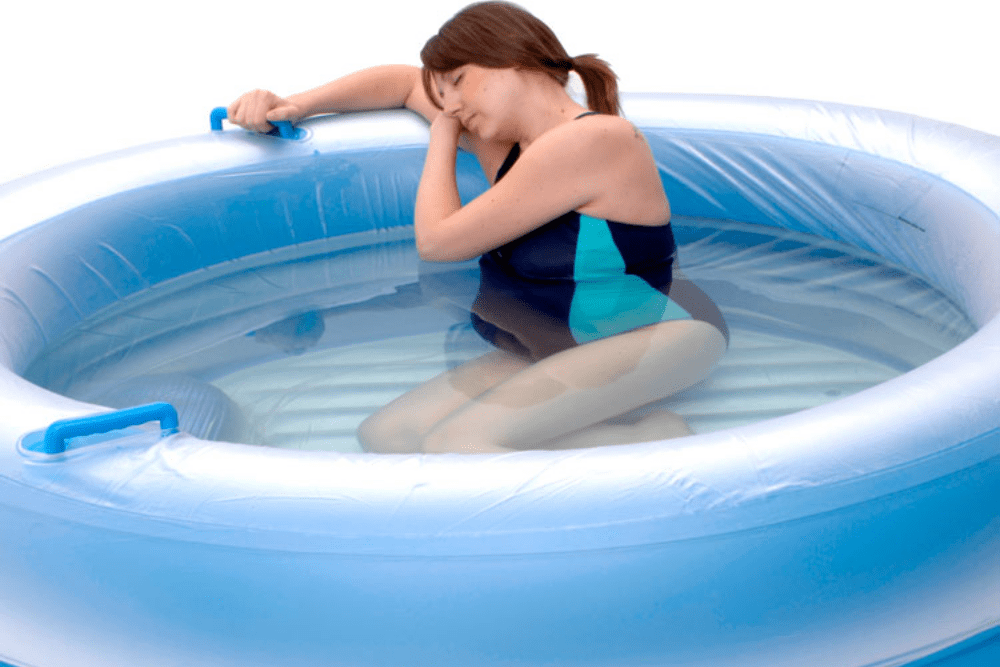
The use of water in labour is a centuries-old practice for the human race. However today, many people are either unaware or sceptical of whether birth pools are beneficial in labour. The concept of using water in labour is a fairly simple one. If you are a bath person you will understand. This is because it is as simple as hopping into a warm bath after a long, hard day. As your body slips beneath the surface of the water you feel a sensation of instant relief, as though the stress, and cares of the day, and any pain you are experiencing, are literally washing away.
However, while the act of getting into a birth pool is a simple one, the response of your body and brain to submersion in water is highly complex. Pain during labour comes from the uterus, cervix, pelvic joints and ligaments, and at birth from the vagina and perineum. Like the pain of any sort, pain impulses are carried from these areas to your spinal cord where they are fast-tracked to your brain – and you feel pain! In the 1970s though researchers found that by quite literally giving your brain a different sensation to focus on, we can stop or at least partially block pain sensations.
So how are birth pools beneficial in labour?
When a woman in labour gets into a birth pool, fibres throughout her body that are sensitive to touch and temperature are stimulated. She feels an instant sense of relief as her body becomes weightless in the water. Just as the sensation of pain heads straight for the spinal cord, so too does this sensation of pleasure. The sensation of pain then has to compete with the pleasurable sensations for access to the brain. It’s like two queues of people trying to walk through a doorway side by side. The more pleasure that gets through the doorway the less pain signals make it to the brain, and the less pain the labouring woman feels.
In the UK birth pools have become well integrated into maternity care for women. This is particularly in midwifery-led settings like birth centres, public hospitals and homes. Recently a study was conducted in the UK which attempted to determine if birth pools are beneficial in labour. It compared the differences in the way labour progresses, the inventions that occur and the outcomes for women and their babies when birth pools are used. They also looked at how these outcomes can differ depending on where the women laboured and birthed – at home, in a free-standing birth centre, in a hospital-attached birth centre or in a hospital. The study took in just over 8,900 women, all considered at low risk of birth complications, including both women experiencing their first birth and those who had birthed before.
Birth in Water
Of the 8,900+ women, the vast majority went into labour naturally, with about 60 per cent giving birth in water. Of these, about half were birthing for the first time. The first-time mothers who used a birth pool at home or in a free-standing birth centre (not attached to a hospital), were less likely to have their waters broken artificially. They were also less likely to use an epidural or other pain relief, or have an episiotomy.
In addition, less first-time mothers were transferred to a hospital from the free-standing birth centres than from hospital birth centres. However, on the flipside more first-time mothers were likely to receive interventions if they were birthed in a hospital or attached birth centre. No differences were seen in the outcomes for babies regardless of where they were born. If it’s in, an attached or free-standing birth centre, hospital – or whether or not a birth pool was used.
So what does all this tell us?
It tells us that birth pools are beneficial during labour! Using a birth pool, particularly if you are having your first baby, gives you a better chance of having a spontaneous and normal birth, without medical intervention. It also tells us that these benefits are accentuated if your birth occurs at home or in a free-standing birth unit. This suggests that despite the presence of midwives and a birth pool you are less likely to have a normal birth in hospital care. This is certainly supported by other studies.
For those who have used a birth pool for birth, and for midwives who recommend them, the results of this study are probably not too surprising. Logically if a woman is experiencing less pain she is less likely to need pain relief – remember pleasure and pain trying to get through that door to the brain? If a woman does not use pain relief her body is more able to respond to labour and progress to birth, supported by a subtle yet highly complex chain reaction of hormonal responses.
To put it simply, less pain equals more chance of a normal birth; using a birth pool equals less pain; so using a birth pool in labour and birth equals a greater chance of normal birth. Finally, the results of this study also support others who have shown that the use of water reduces rates of intervention and that for low risk women, home birth is at least as safe as hospital birth. Birth pools ARE beneficial in labour!
Reference
Burns, E.E. et al., 2012. Characteristics, Interventions, and Outcomes of Women Who Used a Birthing Pool: A Prospective Observational Study. Birth, 39(3), pp.192–202.
Page revised on 20th December 2021


Recent Comments